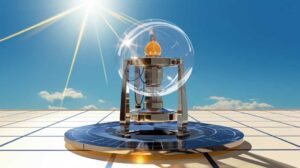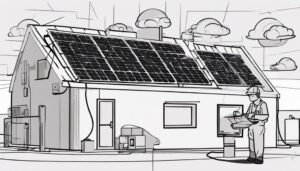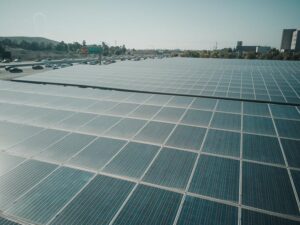As you step into the realm of solar energy, a world of possibilities unfolds before you.
From the intricate design of solar panels to the intricate dance of photons and electrons, each aspect of solar power holds a key to a sustainable future. But what exactly makes solar energy so compelling, and how can you tap into its potential?
Stay tuned as we unravel the mysteries of solar power and shed light on the path towards a brighter, more energy-efficient tomorrow.
Key Takeaways
- Solar panels convert sunlight into electricity using silicon wafers and metal components efficiently.
- Solar power systems consist of panels, inverters, and isolators to convert and manage electricity safely.
- Understanding power (kW) and energy (kWh) is essential for sizing and evaluating solar systems accurately.
- Solar energy production leads to significant electricity bill savings, especially with proper maintenance and monitoring.
Solar Panel Fundamentals
To grasp the essence of solar panel fundamentals, delve into the intricate workings of solar cells and their role in electricity generation through the photovoltaic effect.
- Solar panel efficiency is a critical aspect determined by factors like cell quality, design, and environmental conditions.
- Silicon wafer technology, commonly used in solar cells, plays a pivotal role in converting sunlight into electricity. These wafers are layered with metal fingers and busbars to enhance conductivity and maximize power output.
The efficiency of solar panels directly correlates with the quality and purity of the silicon wafers utilized. Understanding the complexities of silicon wafer technology is paramount in optimizing solar panel efficiency and overall performance.
Components of Solar Power Systems
Understanding the intricacies of solar panel fundamentals lays a foundation for comprehending the components of solar power systems that work harmoniously to harness and convert sunlight into electricity for various applications.
- Solar power systems consist of crucial components like solar PV panels that absorb sunlight to generate DC electricity, inverters that convert DC to AC for household use, and isolators for safety. System maintenance is vital to ensure optimal performance and longevity.
- Regular checks on connections, cleaning panels, and monitoring inverters are essential. Safety precautions include using appropriate protective gear, following manufacturer guidelines, and understanding how to safely isolate components.
- Proper maintenance and adherence to safety protocols are key to maximizing the efficiency and lifespan of your solar power system.
Understanding Power and Energy
Delve into the distinction between power and energy within solar systems to grasp the fundamental principles governing their operation and output efficiency.
- Power (kW) denotes the rate of electricity generation or consumption, while energy (kWh) represents the total electricity produced or used over time.
- Solar systems are sized in kilowatts for power output, with energy consumption measured in kilowatt-hours for billing.
- Understanding power consumption and energy efficiency is crucial for properly sizing and evaluating solar systems.
- Energy efficiency ensures maximum utilization of the power generated, while power consumption impacts the system’s performance.
Energy Production and Savings
Efficient energy production in solar systems is crucial for maximizing savings and ensuring optimal performance over time.
- Proper maintenance and monitoring enhance system efficiency.
- Battery storage allows for surplus energy utilization.
- Maximizing savings involves understanding feed-in tariffs and energy consumption patterns.
Monitoring your solar system regularly ensures it’s producing at its peak capacity. By storing excess energy in batteries, you can use it during low sunlight periods, further reducing your reliance on the grid. Understanding feed-in tariffs and your energy usage patterns helps you capitalize on credits and optimize your system’s performance to maximize savings in the long run.
Benefits of Solar Energy
To optimize the benefits of solar energy, maximizing efficiency through proper maintenance and monitoring is essential. Solar energy is a key player in the realm of renewable energy, offering you the advantage of energy independence.
By harnessing the power of the sun, you can reduce your reliance on traditional grid electricity and take charge of your energy production. This not only contributes to a cleaner environment by reducing carbon emissions but also provides you with long-term cost savings on your electricity bills.
Embracing solar technology allows you to tap into government incentives and rebates, making your solar installation more cost-effective. As you plan for the future, integrating solar power with electric cars and home batteries enhances your energy independence and sustainability.
Future Solar Considerations
Considering the rapid advancements in solar technology, it’s imperative to evaluate potential system expansions to meet future energy demands efficiently.
- Electric Vehicle Integration: Solar systems can be designed to support the charging needs of electric vehicles, promoting sustainable transportation solutions.
- System Expansions: Planning for scalable solar installations allows for easy expansion to accommodate increased energy requirements over time.
- Efficiency Enhancements: Incorporating the latest technological improvements in solar panels and inverters can boost overall system efficiency, enhancing energy production and cost-effectiveness.
Solar Technology Advancements
With the rapid evolution of solar technology, staying abreast of the latest advancements is crucial to maximizing the efficiency and effectiveness of solar power systems. Recent innovations have led to improved efficiency and cost-effectiveness in solar technology, making it a more attractive option for sustainable energy solutions.
Advancements such as PERC (Passivated Emitter Rear Cell) and bifacial solar panels have significantly increased energy output while reducing overall costs. The table below highlights some key technological advancements in the solar industry:
| Technology Advancement | Description | Benefit |
|---|---|---|
| PERC Solar Cells | Passivated Emitter Rear Cell technology for enhanced efficiency | Improved energy generation |
| Bifacial Panels | Panels that can capture sunlight on both sides for increased output | Higher energy yield |
| Smart Inverters | Inverters with advanced monitoring and control capabilities | Optimized system performance |
| Thin-Film Technology | Lighter and more flexible panels for diverse installation options | Versatile and easy to deploy |
| Solar Tracking Systems | Panels that follow the sun’s path for maximum sunlight exposure | Enhanced energy production |
Government Incentives and Rebates
Government incentives and rebates play a pivotal role in making solar installations more economically viable and accessible for homeowners and businesses alike. These programs offer significant financial benefits, making the initial investment in solar technology more manageable.
Additionally, they encourage individuals to adopt renewable energy sources, which positively impact the environment by reducing carbon emissions and promoting sustainability.
- Financial benefits: Incentives such as tax credits and rebates help offset the upfront costs associated with installing solar panels.
- Environmental impact: By incentivizing the use of solar energy, governments contribute to the reduction of greenhouse gas emissions and combat climate change.
- Accessibility: These programs make solar technology more accessible to a wider range of consumers, fostering a greener and more sustainable energy landscape.
Frequently Asked Questions
What Are the Typical Maintenance Requirements for a Residential Solar Power System?
To maintain a residential solar power system, establish a regular cleaning schedule to ensure optimal performance. Check warranty coverage for maintenance services. Clean panels at least twice a year with mild soap and water to maximize efficiency.
How Do Shading and Orientation of Solar Panels Affect Their Efficiency?
Shading impact and panel orientation directly affect efficiency. Shading from trees or obstructions reduces power output. Optimal panel orientation towards the sun maximizes energy production. Understanding these factors ensures you get the most out of your solar system.
What Are the Potential Risks or Hazards Associated With Rooftop Solar Installations?
When considering rooftop solar installations, potential risks include fire hazards due to electrical malfunctions and structural integrity concerns from added weight. Regular maintenance and professional inspections are crucial to mitigate these dangers and ensure safety.
Can Solar Panels Still Generate Electricity on Cloudy Days or During Inclement Weather?
Yes, solar panels can still generate electricity on cloudy days or during inclement weather, but at reduced efficiency. Weather impacts solar panels by hindering sunlight absorption. Solar efficiency decreases on overcast days due to reduced sunlight intensity, affecting energy production.
How to Do Grid-Tied Vs. Off-Grid Solar Systems Differ in Terms of Functionality and Cost?
Grid-tied solar systems connect to the utility grid, allowing excess energy to be sold back. Off-grid systems operate independently, requiring battery storage for energy consumption at night or during outages. Grid-tied systems are typically cheaper due to fewer components.
Conclusion
You have now gained a solid understanding of the fundamental aspects of solar energy, from the construction of solar panels to the components of a solar power system. By learning about power and energy, you can evaluate and size solar systems for optimal performance.
With the benefits of solar energy in mind, including cost savings and environmental impact, you’re well-equipped to embrace the evolving technology and future considerations of solar energy production.
Unlock the power of the sun and harness its potential for a sustainable energy solution.



